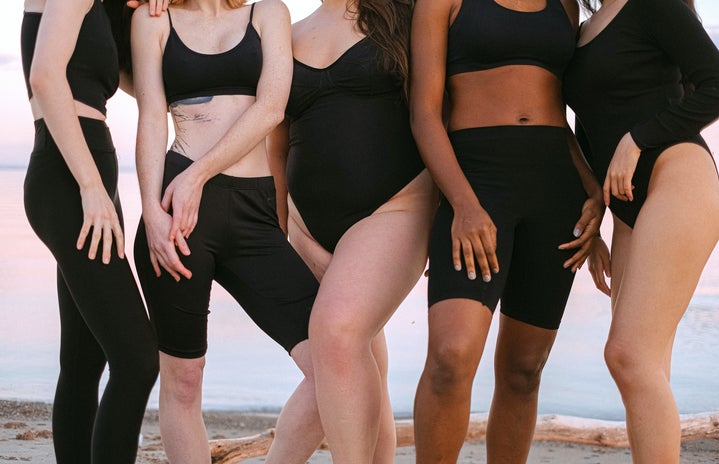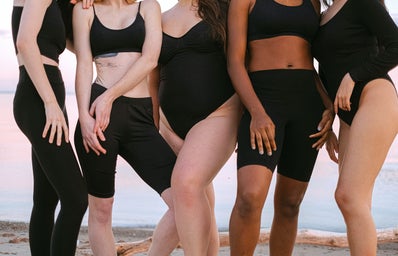Consuming media saturated with fatphobia and eurocentric beauty standards makes it hard to cultivate a positive relationship with your body. For me, critiquing my body in any way often feels like parroting the words of a society that is fatphobic and eurocentric. Do I want to lose weight because I want to? Or because I’ve been taught that larger bodies are shameful? When fatphobia is disguised as a wellness culture, distinguishing between what I want for my body and what society demands is difficult.
We all know what the “perfect” body looks like. No one lives in ignorance of social beauty standards because the discourse around female bodies is public. Women’s bodies are everywhere – pop-up ads, social media feeds, movies, and streaming services. These bodies that are thin enough, white enough, or palatable enough to appear on magazine covers, movie posters, and sponsored Instagram posts rarely come into being without lots of time and thousands of dollars, and they are rarely unedited. Still, they inform what we wear, who we date, and even how much we get paid. These bodies are unattainable for many women, yet they shape the self-image of us all.
So much of societal discourse on women’s bodies revolves around how we can make them more palatable. Eurocentric beauty standards are everywhere, even in seemingly innocuous places. One example is TikTok beauty filters, which consistently make your nose smaller, your skin paler, and your eyes lighter. We cannot deny that this reinforces problematic beauty standards and negative self-image.
In the early 2000s, I read a lot of Cosmopolitan, Marie Claire, and In Style. Beauty articles covered how to dress for your body type, face shape, hair color, undertones, etc. They showed you how to fit yourself into a social ideal, disguising problematic beauty standards as “dressing for your body type” and “highlighting the unique you.” In reality, the “unique you” was the thin, shiny-haired, wide-eyed woman hiding within your body, just waiting to be released by Spanx shapewear and the latest makeup trend. In reality, these articles showed you how to identify all the ways you deviated from the thin, white ideal and neutralize them.
Wellness culture faces the same problems. It is often just fatphobia disguised as self-care. Celebrity success stories talk about how losing weight made them happier, healthier, better. We do not allow women to be fat and happy. There are always bodies that exist outside of social beauty standards, but the beauty industry needs you to hate the way you look a little bit all the time. Enough to buy corrector concealer, Skims shapewear, or a Dyson airwrap. Enough to download Facetune and pay for limited edition filters. We are always striving for thinner, for smaller. We buy clothing that doesn’t fit our bodies because if we can lose just these ten pounds, it will.
In the same vein, health and wellness influencers show you how to measure your days in fasting and your weeks with juice cleanses. Wellness culture can be centered on self-acceptance, mental health, and caring for your body. However, it devolves into a how-to guide to developing the right kind of eating disorder. We don’t try fad diets, have a 28-step skincare routine, or take collagen supplements because they are good for us. We do these things because they create proximity to social beauty standards.
We complain about living on a coffee diet, not having eaten a meal today, or not being able to finish something. We do this as if we are lamenting our inability to treat our bodies with the care and kindness they deserve. Truthfully, it’s a not-so-subtle way of letting other women know that we don’t diet intentionally. We aren’t trying to lose weight. We are perfectly, effortlessly opposed to full bellies. We don’t count calories because we don’t need to. We don’t have to minimize our cravings or bodies because we are naturally ideal women. We are a negative space, empty of any desires except those we fulfill. This is how we romanticize the self-harm that gets us closer to a “perfect” body. How we create womanhood viewed through the male gaze. This is how we turn the self-harm of obsessively monitoring our appearance into self-care.
We know the real emphasis is not on health or comprehensive wellness. It is on appearance. Media inherently prioritizes outward appearance over internal happiness because self-acceptance doesn’t translate well to an iPhone screen. Fitness influencers show you how to build muscle without looking like you’ve built muscle. How to fill this and shrink that. How to lose a little weight just right there so that Emily Ratajowski’s latest fit will look good on you too, and no one will know that you have back fat beneath your free people bra.
The beauty industry is built upon the myth that what looks better is better, and that better generally means whiter, richer, and thinner. Wellness culture creates an oscillation between self-care and self-hatred, and it feeds on social media and influencer culture. It doesn’t matter if you starve yourself or live on caffeine and granola bars. If you post pictures from your pilates class and have a silhouette that could feature in Sports Illustrated, you must be healthy. This idea that appearance is a reflection of internal worth-happiness-morality-goodness extends beyond Instagram and TikTok, even into film and literature. It’s why it’s okay to be the villain, so long as you’re hot.


